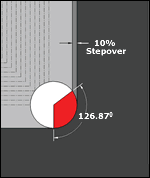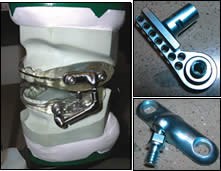Unattended Machining Makes Oral Orthotics More Affordable
This shop makes the oral devices that helped the shop owner and members of his family. Unattended machining is the key to making this therapy more accessible.
Share




It would be difficult to imagine a job shop owner who has a more personal relationship with machined parts than Peter Boucher. At night, parts machined at his shop go into his mouth.
The same is true of programmer Eric Reitan.
Ditto for Mr. Boucher’s son Joshua.
All of them have been fitted with custom oral orthotic devices, and all of them work for 3V Precision Machining of Lakewood, Washington—the shop where the titanium components of these devices are machined.
In each case, the device fits around the teeth and exerts pressure on the jaw to slightly shift the position of the tongue. The aim is to get the tongue out of the way of breathing to improve airflow. The device is part of a therapeutic system developed by Dr. Farrand Robson called “Oral Systemic Balance,” or OSB.
The premise of the treatment is this: When the body is slightly short on air because of the tongue, it makes unconscious accommodations. Snoring is one possible consequence, but more serious consequences may result if the body strains to hold the neck and back in unnatural positions. The exertion can lead to a variety of ailments over time.
Mr. Boucher says his own OSB device cured not only his snoring but also a recurring neck pain. He says it also lifted his emotional state. “I thought I had depression. It turns out I was just exhausted from trying so hard to breathe,” he says.
His sister realized even greater benefits. After she underwent the therapy and began wearing the orthotic device, she was able to lay her cane aside. Eleven years earlier, she was diagnosed with multiple sclerosis. Along with the cane, she relied on a leg brace and suffered a variety of other symptoms. Now the symptoms have been relieved, and Mr. Boucher says the improvement began just as soon as her breathing improved. “It still amazes the family to watch her get up and walk around the room,” he says.
The joy of this, along with other treatment successes he has heard about from Dr. Robson, explains how he can now say quite earnestly that his shop’s role in OSB therapy is the most exciting thing he has ever been involved with in his career.
Two Goals
That career has been eventful. Before opening his own shop, Mr. Boucher crossed the country learning the machining business, working in 38 shops from New England to California. Now, he provides the manufacturing knowledge to complement Dr. Robson’s medical knowledge. 3V makes not only the machined parts but also other components of the orthotic devices, as well as various tools in the treatment kit used by licensed OSB practitioners. Mr. Boucher has helped to develop these parts, and he says he and the doctor share two objectives for how the components are manufactured. They are:
- Manufacturing has to be inexpensive so the therapy can be affordable.
- Manufacturing has to be performed in the United States.
The goals are not incompatible, Mr. Boucher says. Unattended machining is the key. If labor can be applied strategically, then the cost advantage of cheaper labor in other countries disappears. His shop has developed a process for machining the titanium components in which 150 or more pieces can be produced in a single unattended cycle that runs for more than 24 hours.
Long and predictable tool life is necessary to run so long without an operator, he observes. One way the shop meets this requirement is with software that keeps the tool protected.
Tool Path And Tool Life
The machine in this process is a Mycenter HX400iF horizontal machining center from Kitamura Machinery. The shop has two of these. Mr. Boucher says the machine’s geared-head spindle provides both the torque and reliability to power through titanium across long unattended cycles.
Much of the tooling the machine uses for this work comes from Helical Solutions of Gorham, Maine. That tooling includes a seven-flute end mill that Mr. Boucher says is “like a samurai sword through titanium.” Using the 3/8-inch version of this tool, the shop has milled away 400 pounds of titanium at 400 sfm and 180 ipm without measurable tool wear. The design and grind of the tool help account for its effectiveness, he says, but another factor is the way the tool is used. At 3V, the CAM software helps it realize longer life.
The shop’s CAM system is Surfcam “Velocity” software from Surfware. The software includes a toolpath engine called TrueMill that controls the tool’s engagement angle—the portion of the tool circumference that is buried in the material.
Engagement angle usually increases in the corners. A tool cutting at 50-percent stepover has an engagement angle of 90 degrees until it enters a corner, at which point the engagement angle increases to 180 degrees. Similarly, a tool cutting at a 10-percent stepover (see illustration) increases its engagement angle from 37 to 127 degrees when it enters a corner. Mr. Boucher says this is where tool life is lost—not gradually across the cut, but in these sudden bouts of heavy cutting.
“You know that oop! oop! sound you hear as the tool passes through corners? When you hear that, there goes your end mill,” he says.
His shop’s milling doesn’t make that sound. Instead, the sound is level, even as the tool changes directions. This is because the TrueMill engine designs tool paths to keep the engagement angle steady. The result can be a seemingly disordered path, but this pattern keeps the tool’s work consistent. The feature can be applied to permit more aggressive cutting, but Mr. Boucher values the long tool life instead. He actually needs even more life than what is necessary for the shop’s current unattended cycles.
3V requires its tools to be able to run not just through one round-the-clock cycle, but through a full week of these cycles without being replaced. The reason is that Mr. Boucher is preparing to reduce the labor content of his process even further. Today, the machining centers have two pallets apiece, but soon one or both machines will be upgraded to pallet pools. When that happens, he says, the machine will make even more of the orthotic parts in one cycle, with the machine running continuously not for one day, but for several days without any operator attention.
Sidebar: Breathing New Life
The oral orthotic device is one component of Oral Systemic Balance therapy. Here is a description of that therapy from literature on OSB:
Breathing and swallowing are essential to life, so our bodies do what is necessary to help the mouth and throat perform these functions efficiently. For some people, these instinctive efforts cause pain and other symptoms.
The culprit is the tongue. This can prevent the mouth and throat from functioning properly. The tongue can fall back from the mouth to narrow the throat, decreasing air intake and impeding swallowing. Few are conscious of this, but the body automatically adjusts to keep the throat open. It does this so we can survive. The price can include poor posture, headaches, aches and pains in the back and neck, sleep problems, and even stress-like feelings as the body produces adrenaline to help the muscles work better.
OSB therapy addresses these symptoms with a patent-pending system that includes assessment and diagnostic testing along with a custom-designed oral device that helps keep the throat open. This device lets the throat muscles relax, permitting deeper breathing and easier swallowing. The therapy also helps balance the autonomic nervous system, which regulates body functions such as heart rate, body temperature and digestion. As a result of OSB, hidden illnesses can be detected and prescription drugs dependence may be reduced.
In fact, when the therapy is applied by a licensed OSB practitioner, not only can breathing and swallowing improve, but also posture can correct itself naturally, often increasing a person’s height. Chronic pain can be reduced as well, and sleep can become more restful and refreshing.
Related Content
Ametek EMC Laser Cutting System Offers Through-Part Cooling
The new laser cutting system offers comprehensive Swiss machining capabilities, as well as through-part cooling and automatic part-handling options.
Read MoreTungaloy-NTK PCD Grade Optimizes Dimensional Accuracy
The DX200 is an effective tool for machining application-specific components that demand high levels of material purity, such as metal medical implants and sputtering targets for semiconductor applications.
Read MoreKennametal Turning Tools Enhance Small Part, Medical Machining
TopSwiss Micro Boring Solid tooling and KCU25B turning inserts are well suited for the small parts and medical machining space.
Read MoreLyndex-Nikken Collets Enable Accurate Small-Diameter Cutting
The MMC Mini-Mini collet chuck is well suited for high-speed machining applications where clearance is needed, such as die mold, aerospace and medical parts.
Read MoreRead Next
5 Rules of Thumb for Buying CNC Machine Tools
Use these tips to carefully plan your machine tool purchases and to avoid regretting your decision later.
Read MoreRegistration Now Open for the Precision Machining Technology Show (PMTS) 2025
The precision machining industry’s premier event returns to Cleveland, OH, April 1-3.
Read MoreSetting Up the Building Blocks for a Digital Factory
Woodward Inc. spent over a year developing an API to connect machines to its digital factory. Caron Engineering’s MiConnect has cut most of this process while also granting the shop greater access to machine information.
Read More



































